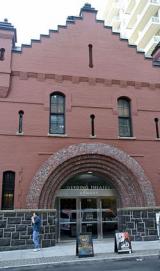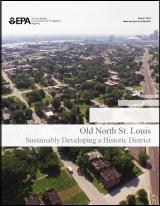Smart Growth and Preservation of Existing and Historic Buildings
Background
The renovation of a historic property is often a starting point and anchor for the redevelopment of a block, street, or district.
- A historic building or district can be a tangible symbol of a community's interest in honoring its heritage, valuing its character and sense of place, getting the most out of prior investments in infrastructure and development, and encouraging growth in already-developed areas.
- Rehabilitating historic properties can be a critical part of promoting energy efficiency by preserving the energy already represented by existing buildings (known as "embodied energy"), rather than expending additional energy for new construction. A new, green, energy-efficient office building that includes as much as 40 percent recycled materials would nevertheless take approximately 65 years to recover the energy lost in demolishing a comparable existing building.1
- Repurposing old buildings—particularly those that are vacant—reduces the need for construction of new buildings and the consumption of land, energy, materials, and financial resources that they require.
Codes and many green building standards do not always provide a clear path for redeveloping and revitalizing historic and other existing buildings to achieve environmentally sustainable outcomes. For example, replacing windows and doors—key elements for an energy-efficient building envelope—often is a challenge to preserving the historic integrity of older buildings.
Communities that seek to both increase their environmentally sustainable investments and protect their historic assets must resolve standards and policies that can at times conflict and could make some projects financially infeasible. Yet the value in overcoming these obstacles is clear—not only for the energy benefits they offer, but also for broader economic, cultural, and land use preservation advantages.
This page lists resources for communities that want to invest in and rehabilitate existing buildings, regardless of whether the buildings qualify for consideration and review under formal historic preservation provisions (such as Section 106 review triggered by federal action). These resources can help inform a community's approach to smart growth through historic preservation and identify ways to overcome challenges.
Resources
EPA, Old North St. Louis: Sustainably Developing a Historic District (2016): Report from a technical assistance project to help the Old North St. Louis neighborhood develop a vision that would guide new growth and development in a manner that protects, preserves, and rehabilitates its historic character while incorporating environmentally sustainable features that enhance the quality of life for residents and visitors.
EPA, Lead Renovation, Repair and Painting Program: Describes policies and recommended practices to safely renovate and protect against the dangers of lead often found in older homes.
EPA, Sustainable Solutions for Historic Homes in Northern California: A voluntary green code and green rehabilitation manual developed to support renovation for historic homes (developed through an award made under EPA's Brownfields Sustainability Pilot grant program).
National Park Service, Sustainability and Historic Preservation Lessons Learned (PDF) (29 pp, 4.4 MB, About PDF) (2007): Presentation summarizing how to preserve historic buildings and still achieve LEED certification, using examples from throughout the country.
National Park Service, Tax Incentives for Preserving Historic Properties: Encourages private-sector investment in the rehabilitation and reuse of historic buildings.
National Park Service, Weatherizing and Improving the Energy Efficiency of Historic Buildings: Information from NPS' Technical Preservation Services on how to improve the energy efficiency of existing buildings through user modification as well as changes to the building.
National Trust for Historic Preservation, Sustainability: Exit Resource page for articles, case studies, and links related to sustainability, including resources on green building, building reuse, and sustainable communities.
Main Street America, UrbanMain: Exit Offers community-driven economic development services to help older and historic neighborhood commercial districts restore economic vitality and improve quality of life.
State of New Jersey's Rehabilitation Subcode: Exit Describes the approach that New Jersey used to modified its building code to encourage rehabilitation of existing structures, and indicators of its success.
San Francisco Green Building Ordinance Exit (incorporating protections for historic properties): Code language adopted by San Francisco that encourages green building and includes provisions for preserving historic building components.
Whole Building Design Guide, Sustainable Historic Preservation: Exit Resources, codes and standards, and other information on sustainable renovation and reuse of historic buildings from the National Institute of Building Sciences.
1 Moe, Richard. "Sustainable Stewardship." Traditional Building, June 2008.


